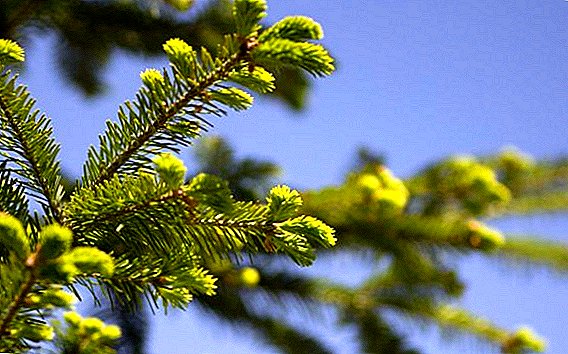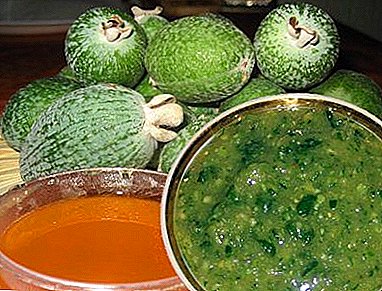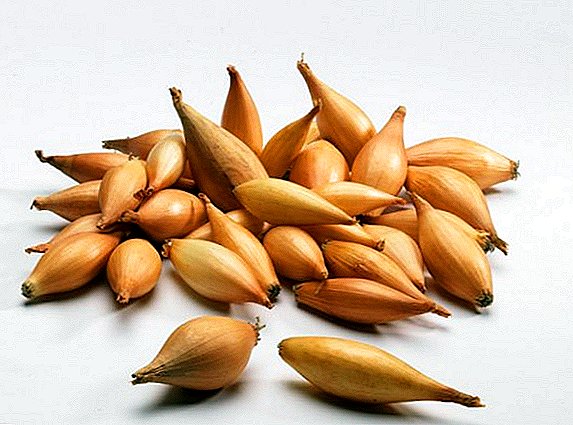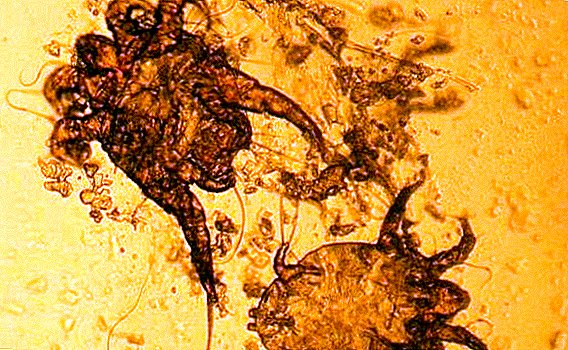 For more than a century and a half, mankind has been trying to eradicate chorioptosis in cows, a universal invasive disease of all ruminants caused by skin mites. However, despite the prevalence of disease and progress in the field of veterinary science, the epizootology of bovine scabies, its clinical manifestation and methods of treatment have not yet been fully studied. What constitutes a disease, how it is dangerous, and what every farmer should know in confrontation with blood-sicking parasites - read further in the article.
For more than a century and a half, mankind has been trying to eradicate chorioptosis in cows, a universal invasive disease of all ruminants caused by skin mites. However, despite the prevalence of disease and progress in the field of veterinary science, the epizootology of bovine scabies, its clinical manifestation and methods of treatment have not yet been fully studied. What constitutes a disease, how it is dangerous, and what every farmer should know in confrontation with blood-sicking parasites - read further in the article.
What is this disease
Chorioptosis is an acute or chronically occurring disease of cattle, which is characterized by the appearance of inflamed lesions on the skin, hair loss, itching, exhaustion.  In sick individuals, the protective functions of the body decrease, which provokes the occurrence of infections. At the same time, milk yield falls by 20%, and weight gain in young animals - by 30-35%.
In sick individuals, the protective functions of the body decrease, which provokes the occurrence of infections. At the same time, milk yield falls by 20%, and weight gain in young animals - by 30-35%.
Did you know? After each meal, the mite's weight increases 120 times.
Causative agent, development cycle
The appearance of cow scabies is provoked by the Chorioptes Psoroptidae skin mites, which feed on dead epidermal scales and inflammatory exudates. In their structure, they are very similar to the skinheads, however, they are characterized by smaller body size and its oblong-oval shape. Parasites have 4 pairs of five-segmented limbs with bell-shaped suckers.  Mites of the genus Chorioptes Females are characterized by sizes up to 0.40 mm, and males - up to 0.33 mm. During the period of their life, the choreoptes undergo a full development cycle. To do this, it is enough for them to settle in the skin of an animal and in 2-3 weeks the egg transforms into a larva, which in turn is transformed into a protonimph, a teleonym, and only then into an imago. The cycle time depends on the state of the organism of the host animal, temperature and humidity of the environment.
Mites of the genus Chorioptes Females are characterized by sizes up to 0.40 mm, and males - up to 0.33 mm. During the period of their life, the choreoptes undergo a full development cycle. To do this, it is enough for them to settle in the skin of an animal and in 2-3 weeks the egg transforms into a larva, which in turn is transformed into a protonimph, a teleonym, and only then into an imago. The cycle time depends on the state of the organism of the host animal, temperature and humidity of the environment.
Skin ticks are very hardy. In empty livestock buildings, they retain their viability for 65 days. In the cold season, when the thermometer drops to -15 ° C, the activity of parasites decreases only after a day. In the conditions of a 9-degree frost they can live more than a week.  The most common causative agents of chorioptosis in cattle are localized to:
The most common causative agents of chorioptosis in cattle are localized to:
- pelvic limbs;
- tail base;
- udder;
- thighs
Did you know? An adult parasite can starve for 2 years without harm to itself.
Sources of infection
Due to the high survival rate of ticks, chorioptosis has spread widely in all climatic zones of the globe. At different times, outbreaks of this invasion have been registered in the farms of Ukraine, Russia, Belarus, Kazakhstan and other countries. Experts note the high risks of infection of animals, which are contained in the conditions of gross violations of zootechnical norms. Usually, such farms do not carry out planned preventive disinfection. And also the rules of quarantine are not observed when importing a new livestock.  According to experts, the sources of cow scabies are:
According to experts, the sources of cow scabies are:
- infected animals (ticks spread to new locations with direct contact of ruminants);
- a pasture where individuals with horiptosis were grazed;
- cleaning equipment that was used in a room with a sick cattle.
Important! Chorioptosis is affected mainly by adult animals from 6 months of age and older.
The spread of the disease is accompanied by the following factors:
- use of intensive cattle rearing technology;
- asymptomatic course of the disease;
- post-stress itching;
- poor unbalanced diet (the disease is the result of a decrease in the functional of the immune system);
- violation of animal health standards;
- lack of individual care items;
- neglect regular checkups wards veterinarian;
- lack of solar insolation and exercise.
 It has been scientifically proven that the most comfortable conditions for the development of horiptosis pathogens are air temperatures below +15 ° C and dampness.
It has been scientifically proven that the most comfortable conditions for the development of horiptosis pathogens are air temperatures below +15 ° C and dampness.Symptoms
Pathology applies to all breeds of cattle and small ruminants, usually proceeds with pronounced clinical signs. In case of infection in a patient, the following are observed:
- severe itching that increases at night, in wet and rainy weather, and also after the haul;
- inflammation of the skin;
- crawling out of the affected areas;
- increased animal attention to the infected area of the skin (cows and bulls usually often lick the back of their bodies and limbs);
- coarsening of the skin, which is very similar to eczema (the affected epidermis becomes folded, covered with gray cracks, the edges of which are very thickened);
- intensive weight loss and milk loss;
- difficulty moving (lameness);
- deterioration of the general condition;
- anxiety;
- increase in local temperature.
 The initial symptoms of the disease in cattle always begin with the sacrum and hind legs. In the absence of timely therapy, skin parasites begin to develop on the lateral surfaces, back, belly, and udder.
The initial symptoms of the disease in cattle always begin with the sacrum and hind legs. In the absence of timely therapy, skin parasites begin to develop on the lateral surfaces, back, belly, and udder.Did you know? Ticks bite everything that has a temperature of +37 ° C.It is characteristic that at the initial stages of the development of horiptosis, violations of the structure of the epidermis are almost imperceptible. On palpation of the hip areas of the skin, as well as the tail, small areas with ruffled coat are barely perceptible. Later, they will appear redness and peeling.
Diagnostics
Today, even experienced veterinarians have difficulty differentiating the clinical signs of illness. Many confuse it with ringworm, psoroptosis and lice. For many years, cow scabies remained unnoticed, because it was interpreted as the consequences of disturbed metabolic processes and stress.  To a more detailed analysis of the symptoms pushed the ineffectiveness of the applied therapy. Contemporaries to determine the causes of discomfort in cows, as well as to diagnose, conduct the following activities:
To a more detailed analysis of the symptoms pushed the ineffectiveness of the applied therapy. Contemporaries to determine the causes of discomfort in cows, as well as to diagnose, conduct the following activities:
- visually assess the condition of the animal, taking into account the epizootological data;
- scrapings are removed from the affected skin for laboratory tests (in the case of chorioptosis, 50 to 200 parasitic mites are visible under the microscope).
Important! Disinfection in the barn is recommended for each semester using sodium hydroxide, chloramine, formaldehyde and hydrated lime..
Pathological changes
The pathogenesis of chorioptosis is based on the morpho-functional changes in the skin that result in impaired biochemical homeostasis. In sick animals, the formula of blood and lymph changes completely, which is caused by the intoxication of the body with the products of ticks.  Parasites inhabit the surface layers of the epidermis, sucking out its exudate and dead scales with the help of a long proboscis. Discomfort and unbearable itching cause chitin spines that cover the entire body of the skin. Every time it moves, the skin becomes irritated, which provokes inflammation, cracks, bleeding and coarsening.
Parasites inhabit the surface layers of the epidermis, sucking out its exudate and dead scales with the help of a long proboscis. Discomfort and unbearable itching cause chitin spines that cover the entire body of the skin. Every time it moves, the skin becomes irritated, which provokes inflammation, cracks, bleeding and coarsening.
In addition, with their horn apparatus, pathogens form microtraumas in the stratum corneum of the epidermis. Their number at times increases with each new population. In the initial stages of development of cow scabies, inflamed nodules are palpable in the shape of a pea.
By invasive diseases can also be attributed to dictyocaules, teliasiasis and fascioliasis.
Over time, the following processes occur in the affected area:
- cell swelling;
- swelling of the subepidermal layer;
- degenerative changes in epithelial cells and hair follicles;
- hair rejection (alopecia);
- the transformation of nodular rash into blisters and pustules;
- immunopathological reactions;
- violation of the integrity of the basement membrane, damaging the sensitive nerve endings;
- development of allergic dermatitis and itching.
Important! When choosing acaricidal drugs for the treatment of chorioptosis, it is necessary to take into account their environmental safety, high activity against parasites, and harmlessness to animals and humans.According to studies, in animals in the first degree of manifestation of clinical signs of chorioptosis, the changes related to the number of leukocytes (there were 6.49% less than the norm). With the second degree of manifestation of symptoms, the concentration of leukocytes by 8.7%, hemoglobin - by 3.7%, erythrocytes - by 3.49%, total protein - by 4.32% decreased.
 Deeper decline in these indicators is observed in animals in the neglected forms of the disease: hemoglobin concentration - by 8.9%, erythrocytes - by 14.16%, total protein - by 7.3% less, and white blood cells - by 30.83%. In addition to internal transformations, other changes that are not related to the skin are obvious. For example:
Deeper decline in these indicators is observed in animals in the neglected forms of the disease: hemoglobin concentration - by 8.9%, erythrocytes - by 14.16%, total protein - by 7.3% less, and white blood cells - by 30.83%. In addition to internal transformations, other changes that are not related to the skin are obvious. For example:- puffiness of the eyelids;
- pulmonary hyperemia;
- swollen lymph nodes;
- lack of fat deposits in the subcutaneous tissue;
- laxity of the muscular corset;
- internal organs with signs of congestive plethora;
- swelling of the mucous membranes of the digestive tract and respiratory tract;
- the presence in the soft tissues of small cavities and fistulas with the presence of serous exudate, bodies and eggs of ticks;
- acanthosis
Did you know? Ticks are the most enduring organisms on Earth. It turned out that they are able to survive in vacuum under the influence of an electron microscope beam.
How to treat sick animals
Timely therapeutic measures will help the animal to fully recover. Moreover, according to veterinarians, superficial skin lesions are easily amenable to medical treatment. In the fight against skin parasites, it is recommended to use acaricides. In most cases, they go on sale in the form of aerosols, suspensions, aqueous solutions that are used for local processing, as well as for bathing livestock. 
In the fight against the causative agents of chorioptosis, they have proven themselves well:
- Ectosan - thanks to the synergistically active substances on which the drug is based, the contact system affects the nervous system of the parasites. The drug is characterized by moderate toxicity for warm-blooded animals and birds. For one-time processing of cattle requires from 1 to 3 liters of working solution. Reapplication is recommended after 9 days.
- Meradok - This is the drug of a new generation of avermectins. That guarantees long-lasting protection against repeated invasions. It is applied one-time. The injection is injected under the skin in the neck area at the rate of 1 ml of solution per 50 kg of animal weight.
- Creolin-X - represents the second generation pyrethroids, characterized by a wide spectrum of action, has a paralyzing effect on all known types of arthropods. For cows and bulls in the treatment of chorioptosis, it is recommended to prepare a 0, 005 percent solution for treating the affected skin. For this purpose, it is enough to spray the water emulsion on the body of the animal, the inflamed aphthas require special attention. Re-processing if necessary is carried out in a week.
Did you know? Cows in terms of their numbers are second in mammals after humans. In the world there are about 1.5 billion. In some countries of Latin America there is one cow per inhabitant, and in Australia this living creature is 40% more than people.
- Purofen - It is a low-risk broad-spectrum drug. When bovine scabies it is recommended to apply it twice, by applying along the spine. For each cow, 10 mg is sufficient. Re-processing is carried out in 10 days.
- Deltsid - insectoacaricide with a pronounced intestinal and contact action. It is active against all types of ticks, bedbugs, lice, fleas, mosquitoes, flies, gadflies. It is a moderately hazardous substance. For cattle, a 0.125 percent concentration is applied by spraying cattle. After 10-12 days, the procedure is repeated. For each animal will need about 1.5-3 working solution.
- Phenoxyphene - complex drug contact action. For guaranteed death of parasitic organisms, 0.024% of the active substance is necessary. The medicine is applied to the cows in an aerosol way, completely covering the whole body. And after 10 days the procedure is repeated. A month after the therapeutic course, the restoration of wool will begin.

Preventive measures
If you take good care of the horned wards and provide them with good nutrition, scabies will not threaten them. And for this, each farmer must do the following:
- observe the rules of quarantine maintenance of newly received cattle (he will need not only a separate pen, but also preventive treatment);
- choose pastures isolated from other farms;
- not to allow grazing of animals along the running tracks;
- annually carry out the treatment of the entire population of acaricidal means (for the purpose of prevention);
- regularly conduct veterinary and sanitary inspections of livestock;
- to organize scrupulous washing and chemical disinfection of cowsheds, as well as cleaning equipment, drinking bowls and feeders every six months;
- provide animals with sufficient walking distance;
- follow the nutritional ration;
- clean the excrement every day and change litter in the barn (it is unacceptable for cows to pile in dirty rooms during the cold season);
- to arrange high-quality ventilation in the shed.
Important! For drinking cows can not use dirty water. And in winter, it is heated to room temperature.Any disease is always easier to prevent than to cure, so do not test the immunity of your cows, take care of their satiety and purity. And the fight against ticks requires patience and financial costs, besides, the effectiveness of treatment depends largely on the correctness of the diagnosis and the choice of acaricides. We hope our article will help you protect your cow from chorioptosis.












